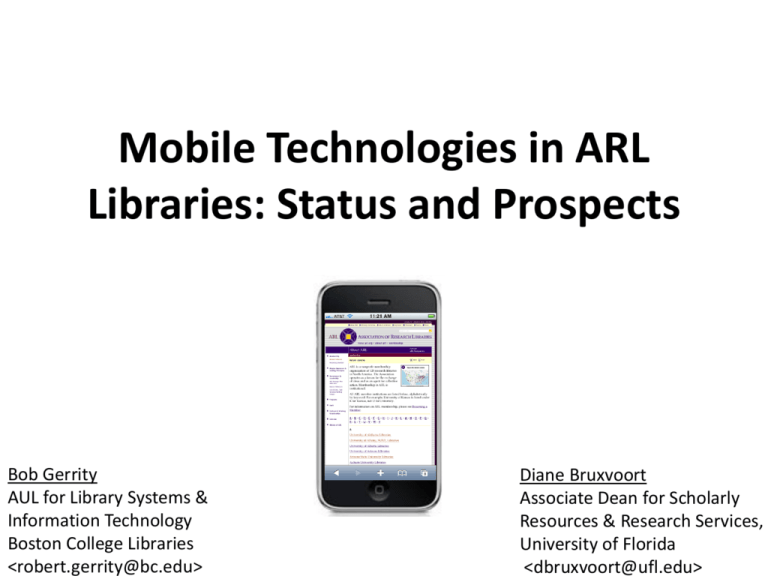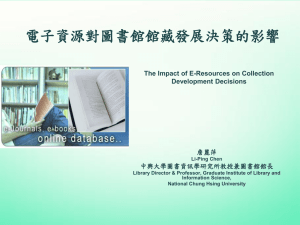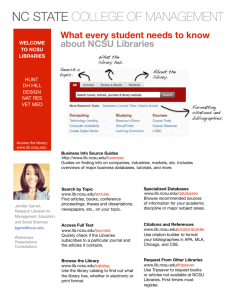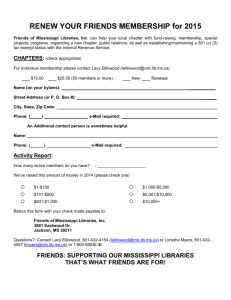Mobile ARL - gttechtrends
advertisement

Mobile Technologies in ARL Libraries: Status and Prospects Bob Gerrity AUL for Library Systems & Information Technology Boston College Libraries <robert.gerrity@bc.edu> Diane Bruxvoort Associate Dean for Scholarly Resources & Research Services, University of Florida <dbruxvoort@ufl.edu> Agenda • • • • • • Background Trends in mobile use Options for mobile website/app development Current status ARL libraries Examples Discussion Background 2007 data Source: John Horrigan, Mobile Access to Data and Information, Pew Internet, March 2008 [http://www.pewinternet.org/Reports/2008/Mobile-Access-to-Data-and-Information/Data-Memo-Findings.aspx ] 2007 data Source: John Horrigan, Mobile Access to Data and Information, Pew Internet, March 2008 [http://www.pewinternet.org/Reports/2008/Mobile-Access-to-Data-and-Information/Data-Memo-Findings.aspx] Lippincott 2008: Key Points • increasing use of cell phones as information discovery tools • mobile devices can be effective learning support tools for Millennial students • changing landscape offers opportunity for academic libraries to play leadership role on campus Call to action • “As with most technology developments, this one is fast-moving. This is not a time to sit on the sidelines as other campus units are developing services for mobile users and licensing content for mobile devices. Academic libraries should make conscious choices about what they want to offer in this arena and act accordingly.” – Joan Lippincott, CNI Mobile Internet: Upward trend continues • In December 2007, 24% of Americans said they had at some point used the internet on their mobile device. • By April 2009, 32% of Americans said they had at some point used the internet on their mobile device. • In December 2007, 11% of Americans said they had yesterday accessed the internet on their mobile. • By April 2009, 19% of Americans said they had yesterday accessed the internet on their mobile. • In 2009, 69% of all adult Americans said they had ever done at least one of the ten activities versus 58% who did this in late 2007. • In 2009, 44% of all adult Americans said they had done at least one of the non-voice data activities on the typical day, up from 32% in 2007. Source: John Horrigan, Wireless Internet Use, Pew Internet, July 2009 [http://www.pewinternet.org/Reports/2009/12-Wireless-Internet-Use.aspx] Global mobile penetration 2010-2015 • By year-end 2010, 1.2 billion people will carry handsets capable of rich, mobile commerce, providing a rich environment for the convergence of mobility and the Web. • by 2013, mobile phones will overtake PCs and the most common Web access device worldwide. The combined installed base of smartphones and browser-equipped enhanced phones will exceed 1.82 billion units. • By 2014, there will be a 90% mobile penetration rate and 6.5 billion mobile connections. • By 2015, context will be as influential to mobile consumer services and relationships as search engines are to the Web. source: Gartner (http://www.gartner.com/it/page.jsp?id=1278413) Smartphone Market Share • In 2010, nearly 1.3 billion mobile phones will ship globally, and 250 million of them will be smartphones. • In the US, where smartphone growth is robust, virtually all phones sold will be smartphones within 5 years. • Smartphone will continue to be the most vital computing/communication device people carry in 2010. • Smartphones won’t be the only computing devices we have or use. • Smartphone displays will never be large enough or clear enough to use for hours of reading or video viewing. source: Frost & Sullivan closer to home “In the developed world, mobile computing has become an indispensable part of day-to-day life in the workforce, and a key driver is the increasing ease and speed with which it is possible to access the Internet from virtually anywhere in the world via the ever-expanding cellular network.” — The Horizon Report 2010 Edition (http://wp.nmc.org/horizon2010/) closer to home source: http://www.educause.edu/Resources/TheECARStudyofUndergraduateStu/187226 Options for mobile development • Native app. • • • application built for specific device, e.g., iPhone can take advantage of hardware features (e.g., accelerometer) proprietary distribution channel (e.g., iTunes) • Mobile web • • vs. • website customized for access from mobile browser often built with tools from MIT Mobile Web Open Source Project standard web technologies, e.g., XHTML, CSS, JavaScript, AJAX Native mobile apps – development environment is complex Source: Wikipedia http://en.wikipedia.org/wiki/Mobile_application_development#Platforms_supporting_devices_by_multiple_manufacturers What to mobilize? • What services are currently available? • What services are applicable on a mobile device? • What services translate well to the mobile environment? • What tools can be created easily? • What would be fun to see? source: David Woodbury, NCSU 15 Guidelines for mobilizing • • • • • Don’t mobilize everything Mobile is not just shrinking the page Use only essential, relevant content Reduce options, simplify Limit data to mobile context, e.g., – for time-oriented date, assume current day/time – assume action oriented • Provide tools appropriate to user’s context • Expose hidden, useful content source: David Woodbury, NCSU Mobile web in ARL: current status ARL Libraries + Mobile: Current State • number ARL libraries with mobile sites/apps: 58 (47%) • Most frequent services: – – – – – – Hours (46) Ask a librarian/chat (27) Search (25) News (20) Locations (18) Databases (18) ARL Libraries Mobile Services 50 45 40 35 30 25 20 15 10 5 0 ARL Libraries + Mobile: Current State • Number ARL campus with mobile sites/apps: 41 (33%) • Most frequent services: – – – – – – – Athletics (32) News (31) Directory (28) Calendar/Events (24) Maps (21) Courses (13) Libraries (13) ARL Campus Mobile Services 35 30 25 20 15 10 5 0 ARL Libraries + Mobile: Current State • number ARL library websites with redirect to mobile site: 23 (40%) • number ARL libraries with iPhone apps: 15 (12%) • number ARL libraries with Droid, BlackBerry apps: TBD Why redirect matters iPhone apps Cornell Illinois Houston Notre Dame* Brown* Vanderbilt* Northwestern** Toronto* Saskatchewan** UC-Irvine** Alberta** Kentucky** Rice** Emory** Princeton** *developed by Boopsie, Inc. **campus app., with library search Vendor mobile services • Databases – IEEE, Gale, EBSCO, Press Display, Google Books, PubMed, • Library Discovery Systems – WorldCat, Primo, Summon, VuFind • Citation Management – RefWorks Examples from the ARL community Ahead of the curve – NC State WolfWalk - NCSU WolfWalk - NCSU http://m.lib.ncsu.edu/wolfwalk Collaborative Approach - Houston source: iPhone app. UHLibrary Undergrad Library Video Tours - Illinois source: iPhone app. ugl4eva Creative campus app – Laundry - Iowa source: http://m.uiowa.edu Arizona State – computer availability source: http://m.lib.asu.edu BYU – floor maps source: http://lib.byu.edu/m BYU – floor maps source: http://lib.byu.edu/m BYU – Search source: http://lib.byu.edu/m Native apps, multiple platforms - Brown source: moBUL iphone app Native apps, multiple platforms - Brown source: moBUL iphone app Library Locations - Alberta source: http://m.library.ualberta.ca Library Locations - Alberta source: http://m.library.ualberta.ca Library Locations - Alberta source: http://m.library.ualberta.ca Coffee queue - NCSU source: http://m.lib.ncsu.edu Coffee queue - NCSU source: http://m.lib.ncsu.edu Youtube – Wayne State source: http://m.lib.wayne.edu Youtube – Wayne State source: http://m.lib.wayne.edu Youtube – Wayne State source: http://m.lib.wayne.edu Discussion Questions • Do you agree that delivering library services to mobile users is important? Why? • What progress has your library made in this area? • What are the obstacles to more rapid movement? • What can ARL do to facilitate? • Would a registry of library mobile sites/services be helpful? • How do you bring public and tech. services together on decision-making for mobile services?








